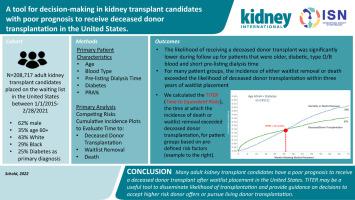Kidney International ( IF 19.6 ) Pub Date : 2022-06-26 , DOI: 10.1016/j.kint.2022.05.025 Jesse D Schold 1 , Anne M Huml 2 , Emilio D Poggio 2 , Peter P Reese 3 , Sumit Mohan 4

|
The primary outcomes for kidney transplant candidates are receipt of deceased or living donor transplant, death or removal from the waiting list. Here, we conducted a retrospective analysis of national Scientific Registry of Transplant Recipients data to evaluate outcomes for 208,717 adult kidney transplant candidates following the 2014 Kidney Allocation System in the United States. Competing risks models were utilized to evaluate Time to Equivalent Risk (TiTER) of deceased donor transplantation (DDTX) and death versus waitlist removal. We also evaluated TiTER based on kidney donor profile index (KDPI) and donor age. For all groups, the cumulative incidence of DDTX was initially higher from time of listing than death or waitlist removal. However, following accrued time on the waiting list, the cumulative incidence of death or waitlist removal exceeded DDTX for certain patient groups, particularly older, diabetic, blood type B and O and shorter pre-listing dialysis time. TiTER for all candidates aged 65-69 averaged 41 months and for 70 and older patients 28 months. Overall, 39.6% of candidates were in risk groups with TiTER under 72 months and 18.5% in groups with TiTER under 24 months. Particularly for older candidates, TiTER for kidneys was substantially shorter for younger donors or lower KDPI. Thus, our findings reveal that a large proportion of wait-listed patients in the United States have poor prognoses to ever undergo DDTX and our data may improve shared decision-making for candidates at time of waitlist placement. Hence, for specific patient groups, TiTER may be a useful tool to disseminate and quantify benefits of accepting relatively high risk donor organs.
中文翻译:

一种用于在美国接受已故供体移植的肾移植候选者的决策工具
肾移植候选者的主要结果是接受已故或活体供体移植、死亡或从等待名单中除名。在这里,我们对国家移植接受者科学登记处数据进行了回顾性分析,以评估 2014 年美国肾脏分配系统后 208,717 名成人肾移植候选者的结果。竞争风险模型用于评估已故供体移植 (DDTX) 的等效风险时间 (TiTER) 和死亡与候补名单删除的比较。我们还根据肾脏供体概况指数 (KDPI) 和供体年龄评估了 TiTER。对于所有组,DDTX 的累积发病率最初比死亡或候补名单删除时更高。然而,随着等候名单上的累积时间,对于某些患者群体,尤其是老年、糖尿病、B 型和 O 型血以及更短的上市前透析时间,死亡或候补名单移除的累积发生率超过了 DDTX。所有 65-69 岁候选人的 TiTER 平均为 41 个月,70 岁及以上的患者为 28 个月。总体而言,39.6% 的候选人属于 TiTER 低于 72 个月的风险组,18.5% 的候选人属于 TiTER 低于 24 个月的组。特别是对于年长的候选人,对于年轻的供体或较低的 KDPI,肾脏的 TiTER 明显更短。因此,我们的研究结果表明,美国大部分候补患者接受 DDTX 的预后较差,我们的数据可能会改善候选人在候补名单放置时的共同决策。因此,对于特定的患者群体,


























 京公网安备 11010802027423号
京公网安备 11010802027423号